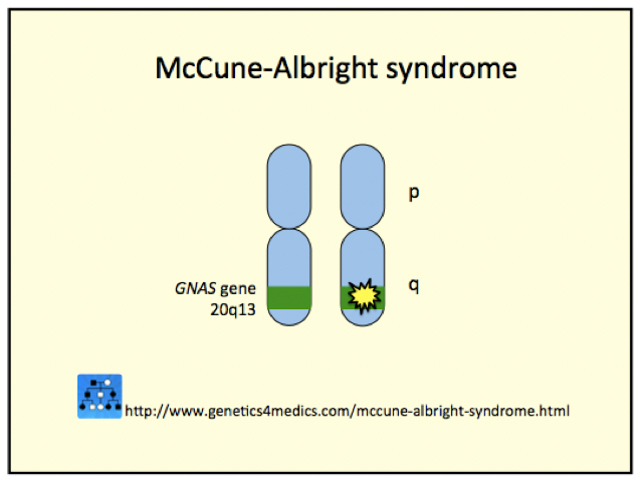Main menu
Common skin conditions

NEWS
Join DermNet PRO
Read more
Quick links
McCune–Albright syndrome — extra information
Introduction
Clinical features
Diagnosis
Treatment
Complications
What is McCune–Albright syndrome?
McCune–Albright syndrome (MAS) is a rare condition that was first described in 1937. It is sometimes called Albright syndrome.
The classic triad consists of 3 features:
- Patchy skin pigmentation
- Bone abnormalities
- Endocrine (hormonal) abnormalities, in particular early puberty
At least 2 of these features need to be present to diagnose the condition. MAS is caused by a spontaneous (chance) mutation in the GNAS1 gene. This gene then forms an abnormal protein that regulates cell proliferation, migration and survival. The mutation occurs early in the development of an embryo and affects only a subset of the patient's cells (called mosaicism). The mutation cannot be passed on to affected patient's children.
What are the clinical features of McCune–Albright syndrome?
1 - Patchy skin pigmentation |
|
|
2 - Bone abnormalities |
|
|
3 - Endocrine abnormalities |
|
|
4 - Other associated problems |
MAS has been associated with a variety of other clinical problems including:
|
|

Genetics of McCune–Albright syndrome*
*Image courtesy Genetics 4 Medics
How is the diagnosis of McCune–Albright syndrome made?
- X-rays of the affected bones show characteristic features such as a central ‘ground-glass’ pattern, lytic lesions (local disappearance of normal bone), cyst-like appearance, and evidence of current or past fractures.
- CT, MRI, and nuclear medicine bone scanning may also be useful.
- Once the condition has been diagnosed, other investigations are required to screen for occult (concealed) endocrine abnormalities.
- Genetic testing is possible, but is not routinely available.
What is the treatment for McCune–Albright syndrome?
- Medical treatment of MAS has had mixed success.
- Early puberty can be treated with various hormonal agents, but results have been inconsistent.
- Bisphosphonate medicines have recently been used to reduce fracture rates and bone pain in patients with MAS. However, results have again been inconsistent.
- Other endocrine problems require specific medication or surgery.
Complications of McCune–Albright syndrome
- Bony changes in the skull can result in damage to nerves causing vision and/or hearing loss.
- Bony changes in the chest wall may lead to difficulty breathing.
- A type of bone cancer called osteosarcoma develops in up to 2% of patients with MAS. This tumour is found most often in patients who have received radiation treatment to affected bone lesions.
- Although 2 long-term studies have shown no increased risk of premature death, several authors have noted unexplained sudden death in patients with severe features of the disease.
References
- McCune-Albright Syndrome — eMedicine dermatology, pediatric diseases
- Albright Syndrome — eMedicine pediatrics, general medicine
- McCune-Albright Syndrome — eMedicine endocrinology
- Dumitrescu CE, Collins MT. McCune-Albright syndrome. Orphanet J Rare Dis. 2008; 3: 12.
- Roth JG, Esterly NB. McCune-Albright syndrome with multiple bilateral café au lait spots. Pediatr Dermatol. 1991 Mar;8(1):35–9.
- HURWITZ CLINICAL PEDIATRIC DERMATOLOGY A Textbook of Skin Disorders of Childhood and Adolescence THIRD EDITION Amy S Paller MD Anthony J Mancini MD ELSEVIER SAUNDERS
- Claudia E Dumitrescu and Michael T Collins. McCune-Albright syndrome. Orphanet Journal of Rare Diseases 2008, 3:12 doi:10.1186/1750-1172-3-12
On DermNet
Other websites
- McCune-Albright Syndrome — Medline Plus
- McCune-Albright syndrome US National Library of Medicine Genetics Home Reference
- McCune-Albright Syndrome — OMIM
- McCune-Albright Syndrome — National Institute of Child Health and Human Development
- Medscape Reference:
